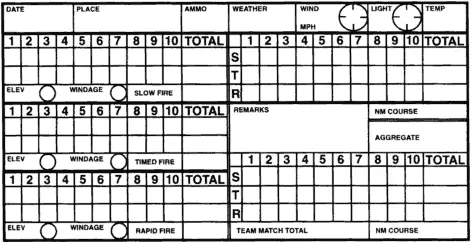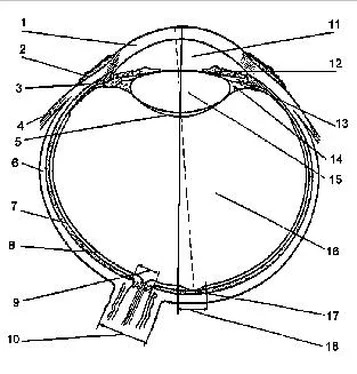1. The sight adjustment card furnishes information on sight capabilities, aids in obtaining a zero and provides a convenient record of sight settings for all caliber weapons.
2. The preparation check sheet provides a convenient list of actions necessary to shoot successfully.
3. The pistol scorebook: The pistol scorebook is a valuable aid to the competitive pistol shooter. It is an individual shooter’s record of all firing by stage, such as slow, timed, and rapid fire, plus National Match Course and the value of all shots fired should be recorded. Practice scores should be kept separate from Match Scores.
The score book is valuable only if it is kept accurately and up to date. Record the bad scores as well as the good ones. By keeping the scorebook accurately it will be an aid in finding weak points in the shooter’s performance. The scorebook will show over a period of time a trend in the shooter’s progress. It will reflect progress in the different stages of fire. Averages may also be kept in the scorebook for each stage of fire. Record of ammunition used, sight adjustment, windage, and elevation, weather, light, wind, temperature, may be an aid to the shooter at a later day. There are many type scorebooks that will do the job well, but choose the one that is simple and will furnish the data you need quickly. An example of pistol scorebook page appears on the following page.
4. Due to the great number of functions necessary for the shooter to apply in exercising control of his shooting, a worksheet for both slow and rapid fire is furnished.
a. The slow fire worksheet provides the shooter with a guide to organization and application of a system for the control of a slow fire shot.
b. The timed and rapid fire worksheet provides the shooter with a guide to the organization and application of a system for the control of a five shot string of timed or rapid fire.

Figure 4-4. Example of the Pistol Scorebook Page.
The champion shooter must be capable of intense concentration and have the sheer guts and determination to adhere to the application of fundamentals in spite of match pressure, adverse weather conditions, discouragement, gun trouble and possible sickness. The best method of sustaining good performance is good organization. To shoot well, do more of the little things right. If you are well organized, overall superiority will result. The knowledge of a systematic approach to controlled shooting must be thoroughly ingrained in the minds of all shooters. The “edge” lies with the shooter with a system.
It should be added that any system will be worthless to a shooter who has indifferent attitudes toward training and who turns the training sessions into a fixed routine, repeating in robot-like fashion the prescribed shooting aspects of a competitive shooter’s activity. It requires not only systematic and painstaking work, but a thoughtful analysis of his work, continuous striving for the new and better, a bold search for the best, and an unwavering strengthening of his will. Only such work on his own shooting methods will turn a shooter’s training into a reliable means of assuring his further development and make it possible for him to win.
(NOTE TO READER — In the original manual (and the wordperfect version) these two worksheets (figures 4-5 & 4-6) were a full page each (Table), with checkboxes to the right of the page. I will do my best... -Richard-)
SLOW FIRE WORKSHEET
PREPARATORY (In assembly area) 1 2 3 4 5 6 7 8 9 10
1. Squadding — Proper Relay & Target
2. Using clean weapons — Proper Caliber
3. Proper sight setting (Zeroed)
4. Blacken sights
5. Ammunition, Ear Plugs & Screwdriver
PREPARATORY (On firing line)
6. Focus scope on proper target
7. Dry Fire for natural Position & Grip
8. Adjust ear plugs
9. Ammunition loaded into magazine
10. Mental Stimulation of Confidence
PLAN DELIVERY OF SHOT (Review Shot Sequence)
11. Extend arm & breathe deeply
12. Settle into minimum arc of movement
13. Pick up sight alignment in aiming area
14. Take up trigger slack — apply initial pressure (take final breath and hold part of it)
15. Maintain sight alignment and minimum arc of movement
16. Start positive trigger pressure
17. Concentrate point focus on front sight
RELAXATION
18. No unnecessary muscular tension (Relax each major portion of body)
DELIVER SHOT (Follow Plan — No Compromise)
19. Follow Through (Continue all control factors)
20. Shot fired as a surprise — No reflex action
SHOT ANALYSIS
21. Call Shot — describe sight alignment
22. Compare hit location with call
23. If shot or call is bad, determine cause
24. Watch for formation of error pattern
25. Did shot break in minimum arc of movement?
26. Hold too long?
27. Positive trigger pressure?
28. Benched weapon why?
29. Lost concentration?
30. Surprise shot break?
31. Worried about results?
POSITIVE CORRECTION (Prompt Application)
32. Include in plan of delivery of next shot.
RAPID FIRE WORKSHEET
PREPARATORY (In assembly area) 1 2 3 4
1. Squadding — Proper Relay and Target
2. Using clean weapons — Proper Caliber
3. Proper sight setting (Zeroes)
4. Blacken Sights
5. Ammunition, Ear Plugs & Screwdriver
PREPARATORY (On Firing Line)
6. Focus scope on proper target
7. Dry fire for natural position & grip
8. Adjust ear plugs
9. Ammunition loaded into magazine
10. Mental Stimulation of Confidence
PLAN DELIVERY OF STRING (Review Sequence)
11. Extend arm & breathe deeply
12. Find sight alignment
13. Find aiming area on edge of target frame (Final deep breath)
14. Settle into minimum arc of movement
15. Point focus on front sight (partly release breath)
16. Take up slack - Initial pressure
17. Maintain sight alignment & minimum arc of movement (Target faces)
18. Start positive trigger pressure
19. Concentrate on sight alignment (First shot is fired)
RELAXATION
20. No Unnecessary Muscular Tension (Relax each major portion of body)
DELIVER STRING OF FIVE SHOTS
21. Follow through and recover with good sight alignment and central hold on each shot of string
SHOT GROUP ANALYSIS
22. Group call. Describe five individual sight alignments
23. Compare group location with calls
24. If group or call is bad, determine cause
25. Surprise break on each of five shots?
26. First shot on time & rhythm maintained?
27. Did shots break in minimum arc of movement
28. Positive trigger pressure?
29. Lost concentration?
30. Ignored minor errors?
31. Worried about results?
POSITIVE CORRECTION (Prompt Application)
32. Include in plan of delivery of next five shots
AN OUTLINE SUMMARY OF THE COMPETE SEQUENCE OF FIRING ONE ACCURATE SHOT
1. Preparation: In assembly area and on firing line
a. Physical
(1) Personal preparation.
(2) Limbering up. Arrive early.
(3) Check out firing line.
(a) Protection from wind and bright or changing sun light.
(b) Smooth and even horizontal surface.
(4) Fit of clothing and shoes
(5) Make final check in assembly area of all necessary equipment and become aware of firing conditions both weather wise and in range operation.
(6) Move to firing line and place equipment on your firing point.
(7) Set telescope up on your target.
Читать дальше













